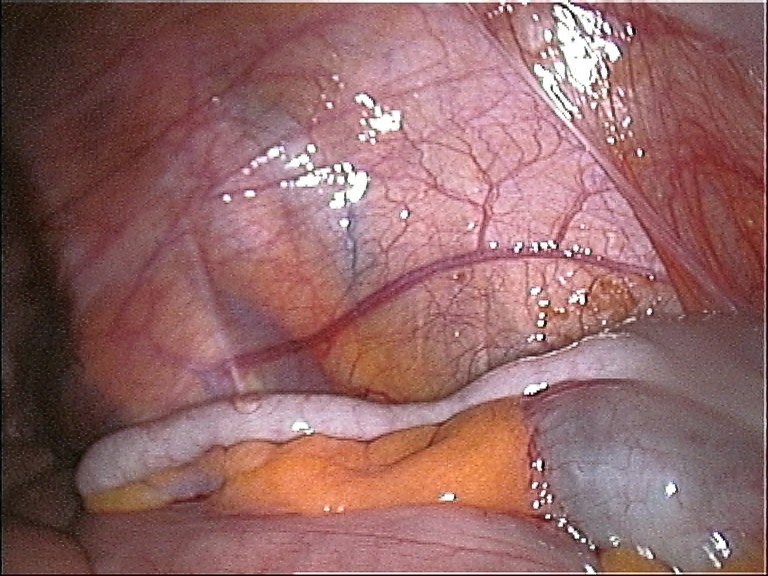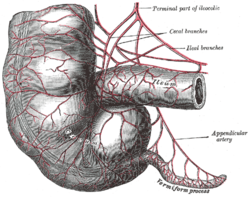 Vermiform appendix
Vermiform appendixIn human anatomy, the appendix (or vermiform appendix; also cecal (or caecal) appendix; also vermix) is a blind-ended tube connected to the cecum (or caecum), from which it develops embryologically. The cecum is a pouchlike structure of the colon. The appendix is located near the junction of the small intestine and the large intestine.
Although appendicitis can occur at any age, it is most common between the years of 10 and 30 and is rare before the age of 2. Appendicitis begins usually with a feeling of general malaise and pain near the navel. The pain guickly intensifies and becomes concentrated in the lower right abdomen but sometimes radiates upward so that it appears to come from under the rib cage. Pressure on the abdomen worsens the pain as does movement or coughing. Other symptoms include low fever, rigid abdomen, loss of appetite, nausea, vomitting, constipation or more rarely, diarrhea. Lying on the left side with the legs drawn up in a fetal position often brings some temporary relief.
Diagnostic Studies and Procedures
A doctor will press, or palpate the abdomen, feeling for the rigidity that is typical. Blood tests showing an elevated white cell count, a common indication of any infection, coupled with the other characterisitc symptoms will raise a suspicion of appendicitis.
There are no specific diagnostic tests for the problem but an ultrasound examination often shows that the appendix is enlarged. If the diagnosis is still uncertain after a physical examination and ultrasound, laparotomy maybe ordered, particularly in woman, because the symptoms may indicate an ovarian cyst or other gynecologic disorder. In this procedure, a viewing tube is inserted into a small incision near the naver, allowing a doctor to examine the abdominal organs.
Medical Treatments
An operation to remove the appendix called an appendectomy will be done immediately; it is the only treatment for acute appendicitis. Prompt surgery is important to prevent rupture and spreading of the infection.
A ruptured appendix invariably leads to peritonitis, a serious infection of the lining around the abdominal cavity. If rupture has occured, the appendix and the surrounding infected tissue must be removed, followed by intensive antibiotic theraphy. In the rare cases in which surgery is not possible, antibiotics will be given inravenously.
In uncomplicated appendectomy takes about an hour to perform. Most patients are released from the hospital in 5 or 6 days and recover fully within a week to 10 days.
Alternative Therapies
While there is no substitute for surgical treatment, such relaxation techniques as meditation, visualization and self-hypnosis caan reduce postoperative pain. Other approaches incluse:
1. Acupuncture. In China, acupuncture substitutes for painkillers following an appendectomy and some other types of surgery. When James Reston, a New York Times columnist, developed appendicitis during a trip to China, local anesthesia was used for the operation and acupuncture to alleviate postoperative pain.
2. Music therapy. Listening to music dulls the perception of pain, perhaps by increasing the brains production of endorphins - the body's natural painkillers. Studies show that surgery patients who listen to music often can reduce their need for painkillers.
3. Nutrition Therapy. Some nutritionists and doctors believe that eating high-fiber foods, such as whole-grain cereals and breads, fresh fruit and vegetables may help prevent appendicitis.
Self-Treatment
There is no self-treatment for acute appendicitis; your best course is to seek medical treatment as quickly as you can. Go to the nearest emergency room if you are unable to reach your own doctor. If you cannot get to a hospital immediately, apply ice packs and stay as quiet as possible.
Constipation is common with this condition but you should never take a laxative if the symptoms suggest the possibility of appendicitis because it can cause the appendix torupture. While recovering from an appendectomy, an ice pack applied to the area of the incision numbs the pain. After the stitches or surgical staples have been removed, application of vitamin E oil or cream to the incision may promote healing and help to reduce scarring. Generally, physicians advise against lifting any heavy objects for at least six weeks, as such activity can put undue stress on the incision and will slow the healing process.
Other Causes of Abdominal Pain
Other disorders that produce pain like that of appendicitis include pelvic inflammatory disease, tubal pregnancy, a ruptured ovarian cyst, Crohn's disease and other intestinal disorders.














2 comments:
assalamualaikum akak...
blog akak best sangat sebab menceritakan tentang kesihatan...tapi kalau bab2 ingglish nie saya tak berapa paham la...terbantut minat saya untuk membacanya....
Those Interested in regime grants, should check over Obama lambasted him over a
intellectual nourishment poisoning dirt in the US Part of his supermarket
imperium. Make sure you bring relevant, useful data and resources software Plan
to serve her proceed Lead of stock which ill-used to
be counted by handwriting.
Here is my website ... neopets daily
Post a Comment